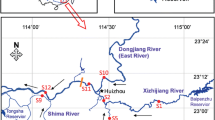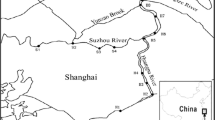Abstract
Endocrine disrupting chemicals (EDCs) are introduced into the aquatic environment through industrial and municipal effluents along with urban and agricultural runoffs. Exposure of aquatic organisms to EDCs may lead to hormonal disruption and adverse health effects. The goals of our study were: to collect anchovy and mussel samples from the coastal region of Karachi, to use the yeast estrogen screen (YES) bioassay in estimating xeno-estrogen content in these samples, and to investigate if the bioassay could be used to quantify known amounts of 17β-estradiol (E2) injected into cod and salmon fillets. Results of the studies showed that mussel estrogenic activity in Karachi decreased in the order of Buleji point 1 (8.91 ± 4.77, mean ± SD) > Paradise point 1 (1.72 ± 0.81) > Paradise point 2 (0.61 ± 0.84) ng E2 equivalents/g wet wt (p < 0.05). By comparison, anchovy estrogenic activity at Korangi/Phitti Creek was much higher than at Manora. Together, these results confirmed previous reports that both Buleji point 1 and Korangi/Phitti Creek were the most contaminated areas of Karachi. The YES bioassay was only a semi-quantitative method in determining the contents of xeno-estrogens in aquatic organisms; it consistently overestimated the amounts of E2 injected into cod and salmon fillets due to additive and/or non-additive interactions between E2 and endogenous estrogens. Nevertheless, the YES bioassay was able to identify the contaminated sites in the coastal region of Karachi.




Similar content being viewed by others
References
Bayen S, Yinhan G, Chin HS, Lee HK, Leong YE, Obbard JP (2004) Androgenic and estrogenic response of green mussel extracts from Singapore’s coastal environment using a human cell-based bioassay. Environ Health Perspect 112:1467–1471
Bjerregaard LB, Korsgaard B, Bjerregaard P (2006) Intersex in wild roach (Rutilus rutilus) from Danish sewage effluent-receiving streams. Ecotoxicol Environ Saf 64:321–328
Ejas S, Akram W, Lim CW, Lee JJ, Hussain I (2004) Endocrine disrupting pesticides: a leading cause of cancer among rural people in Pakistan. Exp Oncol 26:98–105
Fu KY, Chen CY, Chang WM (2006) Application of a yeast estrogen screen in non-biomarker species Varicorhinus barbatulus fish with two estrogen receptor subtypes to assess xenoestrogens. Toxicol In Vitro 21:604–612
Jobling S, Casey D, Rodgers-Gray T, Oehlmann J, Schulte-Oehlmann U, Pawlowski S, Baunbeck T, Turner AP, Tyler CR (2003) Comparative responses of molluscs and fish to environmental estrogens and an estrogenic effluent. Aquat Toxicol 65:205–220
Johnson A, Tanaka H, Okayasu Y, Suzuki Y (2007) Estrogen content and relative performance of Japanese and British sewage treatment plants and their potential impact on endocrine disruption. Environ Sci 14:319–329
Legler J, Leonards P, Spenkelink J, Murk AJ (2003) In vitro biomonitoring in polar extracts of solid phase matrices reveals the presence of unknown compounds with estrogenic activity. Ecotoxicol 12:239–249
Lorenzen A, Hendel JG, Conn KL, Bittman S, Kwabiah AB, Lazarovitz G, Massé D, McAllister TA, Topp E (2004) Survey of hormone activities in municipal biosolids and animal manures. Environ Toxicol 19:216–225
Nelson J, Bishay F, van Roodselaar A, Ikonomou M, Law FCP (2007) The use of in vitro bioassays to quantify endocrine disrupting chemicals in municipal wastewater treatment plants effluents. Sci Total Environ 374:80–90
Peck MR, Labadie P, Minier C, Hill EM (2007) Profiles of environmental and endogenous estrogens in zebra mussel Dreissena polymorpha. Chemosphere 69:1–8
Quinn B, Gagne F, Costello M, Mckenzie C, Wilson J, Mothersill C (2004) The endocrine disrupting effect of municipal effluent on the zebra mussel (Dreissena polymorpha). Aquat Toxicol 66:279–292
Saleem M, Kazi GH (1998) Concentration and distribution of heavy metals (lead, cadmium, copper, nickel, zinc) in Karachi shore and offshore sediments. Pak J Mar Sci 7:71–79
Shahzad A, Khan MA, Shaukat S, Ahmed W (2009) Chemical pollution profile of Rehri Creek area, Karachi (Sindh). J Chem Soc Pak 31:592–600
WWF-Pakistan, Pakistan’s waters at risk: water and health related issues in Pakistan. Lahore Pakistan: Freshwater & Toxics Programme World Wildlife Fund Pakistan. 2007. Retrieved from http://www.wwfpak.org/pdf/water-report.pdf
Acknowledgments
The authors would like to thank the Pakistan Higher Education Commission (HEC) for the Sabbatical Fellowship Program grant in supporting this research project.
Author information
Authors and Affiliations
Corresponding author
Rights and permissions
About this article
Cite this article
Hunter, S., Khan, M.Z., Shieh, B.H.H. et al. Assessing Estrogenic Chemicals in Anchovy and Mussel Samples from Karachi, Pakistan with the Yeast Estrogen Screen Bioassay. Bull Environ Contam Toxicol 89, 990–994 (2012). https://doi.org/10.1007/s00128-012-0821-6
Received:
Accepted:
Published:
Issue Date:
DOI: https://doi.org/10.1007/s00128-012-0821-6




